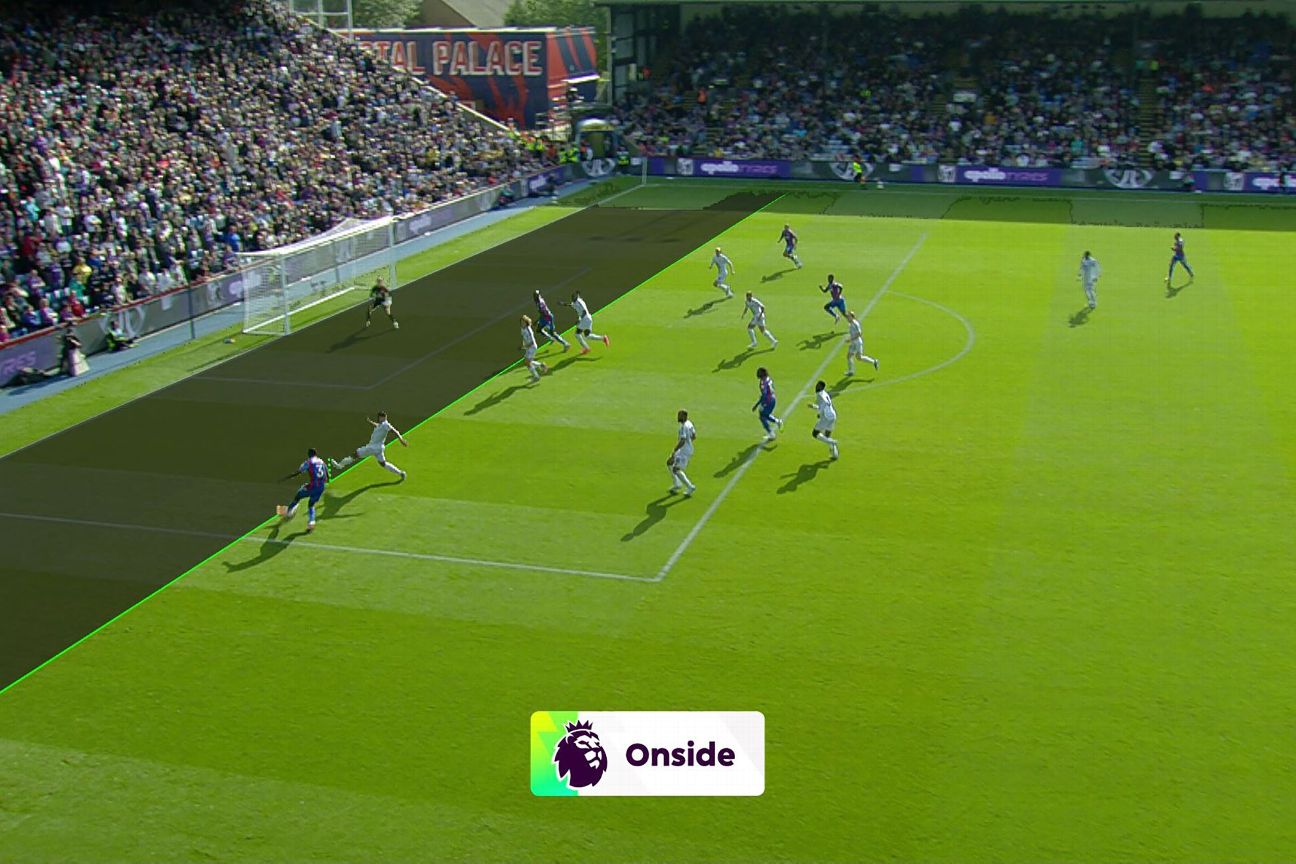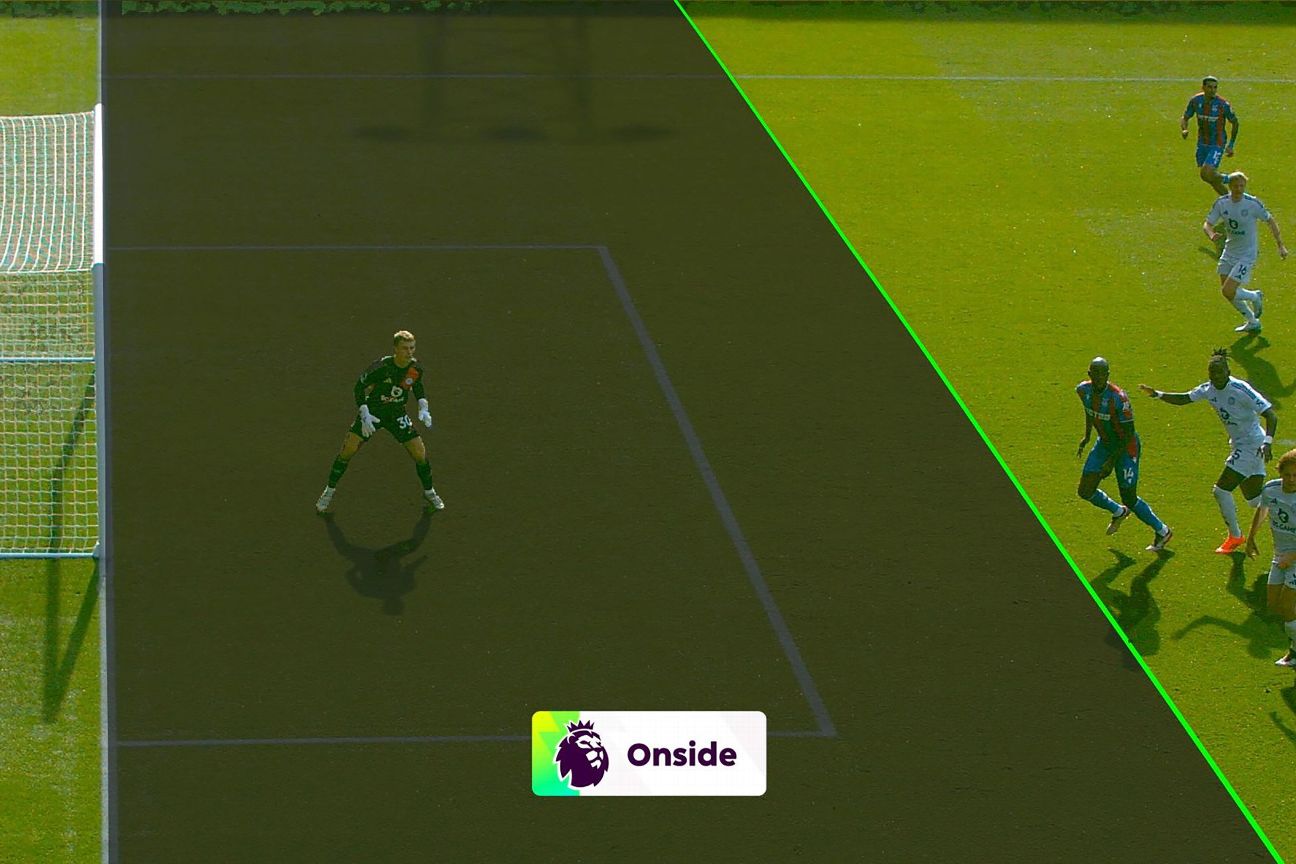Video Assistant Referee causes controversy every week in the Premier League, but how are decisions made, and are they correct?
After each weekend we take a look at the major incidents, to examine and explain the process both in terms of VAR protocol and the Laws of the Game.
In this week’s VAR Review: Why Jurriën Timber‘s challenge differed from Curtis Jones‘ red card at Tottenham Hotspur last season. Plus, why Crystal Palace’s onside goal could be offside in a few weeks, and Aston Villa’s slice of luck against Everton.
Possible red card: Timber foul on Porro
What happened: The game was in the 37th minute when Timber challenged Pedro Porro. The Arsenal defender made contact with the ball then caught Porro. Referee Jarred Gillett showed the yellow card to Timber, and it was checked by the VAR, Stuart Attwell, for a potential red card.
VAR decision: No red card.
VAR review: It’s almost exactly a year since Liverpool midfielder Curtis Jones was sent off at Tottenham through a VAR intervention for a similar challenge on Yves Bissouma — yet there were crucial differences to explain why one was a yellow card and the other a red.
There are a number of factors that a referee, and the VAR, will take into account. Primarily it’s about force, but also the way a player is making the tackle and how they make contact with the other player.
Jones was stretching into the tackle, and with the angle he went into it, he caught his opponent with studs leading into his shin, which created a buckle effect on Bissouma’s leg. That’s one possible indicator of level of force. The buckle doesn’t need to be present for a red card, nor is it necessarily a smoking gun; it’s one possible aspect that might be used to come to a decision.
The nature of the follow through off the top of the ball from Timber was very different. There was only minimal contact, and Timber’s studs were pointing to the ground when he made contact with Porro. There was no force or leading studs, so a yellow card won’t be seen as an on-field error.
It might appear to be a subtle difference, but it’s a textbook comparison between yellow and red card situations when a player goes over the top of the ball and catches an opponent with the follow through.
Possible penalty: Handball by Romero
What happened: Kai Havertz got a header on goal from close range in the 18th minute. It was saved by Guglielmo Vicario, and rebounded on to the arm of Cristian Romero. Could it have been a penalty for handball (watch here)?
VAR decision: No penalty.
VAR review: There’s two reasons why this wouldn’t be a penalty through a VAR intervention. Firstly, Romero has his arm in a position which is explainable for his body movement, and secondly the ball hits him after being played by a teammate — both are exemptions against a handball penalty.
Possible offside: Mateta when scoring
What happened: Crystal Palace thought they had found a way back into the game in the 47th minute when Jean-Philippe Mateta turned home a pass from Tyrick Mitchell, but the assistant’s flag went up for offside. The VAR, Andy Madley, checked the decision.
VAR decision: Goal.
VAR review: The decision to award a goal to Palace angered Leicester City boss Steve Cooper, as his side were 2-0 up at the time and ended up drawing 2-2 after conceding a penalty two minutes into stoppage time.
“I really want to see the absolute offside image of the first goal,” Cooper said afterward. “If it is, no problem, we’ll hold our hands up, but we can’t be calling offsides on suggestions, which is only what we’ve seen at the moment. We need to get that image quickly off the Premier League. If it is, I’ll accept it.”
Cooper’s comments are pertinent, as issues visualising offside decisions from tight camera angles have always been problematic with this technology. It will change when semiautomated offside comes in after one of the international breaks in October or November, as we’ll get an animation that moves to the offside line to clearly show the position of the players. But at the same time, things will change slightly soon (as explained below), though that will be no use to Leicester now.
Until we get semiautomated offside, we are stuck with what we have. And at grounds like Selhurst Park, which don’t have great camera angles, it’s especially difficult.

Cooper said he would be asking the Premier League for the “absolute offside image,” though we do already have these. The Premier League released two images, one from the regular broadcast camera which includes the ball being passed by Mitchell, and the goal-line camera which is intended to show that Mateta was behind the offside line.
Neither are great and you have to know the intricacies of the system to understand what you’re looking at.
If a single green line is displayed, that’s only to the defender and tells us that the decision is so close that the tolerance level has been applied. That’s basically a 5-centimeter benefit of the doubt to the attacker, who might be offside, but the inaccuracies in this technology allow him a little bit of leeway. If the lines to the defender and the attacker are touching, the striker is given onside.

Yet if no line is displayed to the attacker, it can add to the confusion. The goal-line camera angle is supposed to be telling us Mateta is behind it, but without a line to him, it doesn’t really illustrate that.
And then we have the other aspect of semiautomated offside, which effectively creates a two-tier system within the same season. This technology has the tolerance level; semiautomated offside does not due to increased accuracy.
What does that mean? Well, as Mateta was onside within the tolerance level of this technology, he may well be offside with semiautomated. We have a goal for Palace that was ruled onside through VAR in September, yet may well be offside in October.
It raises obvious questions about having two different offside systems in the same season, but the Premier League clubs unanimously voted to bring in the new technology as soon as it’s available, rather than wait until next season. Serie A also introduced semiautomated offside midway through the 2022-23 campaign.
Possible offside: Digne on Watkins goal
What happened: Aston Villa equalised in the 58th minute when Ollie Watkins pounced on an error by Jack Harrison to make the score 2-2. But was there an offside in the buildup?
VAR decision: Goal stands.
VAR review: The move began when Youri Tielemans played a ball over the top to find the run of Lucas Digne down the left side. Digne was being tracked by Harrison, and the Villa player might have been marginally offside when Tielemans made the pass. The goal then came about because Harrison stretched to make an interception and inadvertently played the ball to Watkins.
It’s a niche and often controversial area, where the referee and the VAR have to determine whether an offside player is having a direct impact on a defender. The fact that the offside player is the intended recipient of the pass isn’t enough.
It was decided that Digne wasn’t close enough to Harrison to force him into the error. The goal shows how a defender can be deemed to have simply made a mistake in trying to intercept, even if it seems wholly unfair that the attacking team can effectively benefit from the offside player.
It could have been a different outcome had Harrison touched the ball to Digne — as Digne becomes active for offside if Harrison hasn’t made a “deliberate play” of the ball by stretching for it. As the ball runs to a player who was always onside, the only question is around direct impact by Digne on Harrison, and that was cleared by the VAR as not being a “clear and obvious” error.
Possible red card overturn: Stephens foul on Garnacho
What happened: Jack Stephens was sent off in the 79th minute after bringing down Alejandro Garnacho as the Manchester United player looked to break down the wing. It was checked by the VAR.
VAR decision: Red card stands.
VAR review: At first, a red card seemed a surprising decision from referee Stuart Attwell, but the replay proved it was correct.
Stephens may not have made a great deal of contact on Garnacho, but the challenge was high, catching the forward on the knee with studs leading.
Possible red card: Kovacic challenge on Wissa
What happened: Mateo Kovacic was booked in the 42nd minute for a foul on Yoane Wissa, which forced the Brentford player off with an ankle injury. It was checked by the VAR, Darren England.
VAR decision: No red card.
VAR review: It’s not a great challenge by Kovacic, who goes through Wissa from behind in an attempt to win the ball, though it’s not strong enough for a VAR red card.
Wissa’s injury came from his foot getting caught under the Manchester City player’s hip as he landed on the ground, rather than the nature of the tackle itself, so he’s very unfortunate.
Possible red card: Sanchez foul on Evanilson
What happened: AFC Bournemouth were awarded a penalty in the 36th minute when Chelsea goalkeeper Robert Sánchez collided with Evanilson, who had latched on to a poor backpass by Wesley Fofana and attempted to lift the ball past the goalie. Referee Anthony Taylor pointed to the spot and produced a yellow card, and it was checked for a possible red card by the VAR, Peter Bankes.
VAR decision: No red card.
VAR review: The International Football Association Board (IFAB) has relaxed the guidelines around a red card when a penalty has been awarded several times in recent seasons, so much so that it has to be a reckless tackle, or a deliberate handball, if a player is going to be sent off.
If there is any explanation that a player has made a genuine attempt to either play the ball or challenge an opponent for the ball, there is only going to be a caution.
Sánchez comes out and raises an arm to anticipate that the ball would be played high, so there would always be a natural collision as a result of the goalkeeper trying to stop the ball.
Added to that, Chelsea’s Axel Disasi was the covering defender and might have gotten to the ball before Evanilson had lifted it over the goalkeeper.
Possible penalty: Foul by Kilman on Traore
What happened: Adama Traoré broke into the box in the 15th minute and went down under a challenge from Max Kilman. Referee Tim Robinson wasn’t interested in a penalty and it was checked by the VAR, Paul Tierney.
VAR decision: No penalty.
VAR review: Kilman put a hand on the back of Traore, but there was no real challenge on the Fulham winger.
Fulham boss Marco Silva was incensed on the touchline and ended up receiving a yellow card for his protests, but there didn’t appear enough for the VAR to get involved and overturn the referee’s call in a 50-50 situation.
Some factual parts of this article include information provided by the Premier League and PGMOL.
Source Agencies
